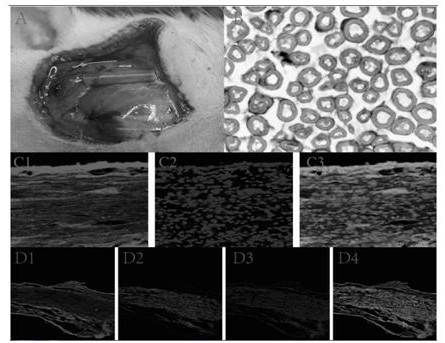Tissue-engineered peripheral nerve tissue and preparation method thereof
A technology of peripheral nerve and tissue engineering, applied in biochemical equipment and methods, tissue regeneration, tissue culture, etc., can solve the problems of insufficient cell volume, influence of cell biological activity, limited length and diameter of autologous nerves, etc.
- Summary
- Abstract
- Description
- Claims
- Application Information
AI Technical Summary
Problems solved by technology
Method used
Image
Examples
Embodiment 1
[0041] The tissue-engineered peripheral nerve tissue prepared in this example uses dedifferentiated adipocytes as seed cells, which are separated, cultured, amplified, and induced into Schwann cells in vitro, and then dedifferentiated adipocyte aggregates are prepared, and finally the cell aggregates are mixed with The silk fibroin catheter scaffold material is compounded to form tissue engineered peripheral nerve tissue, and the specific steps of its preparation are as follows:
[0042] (1) Take 8 mL of adipose tissue from the oral buccal fat pad, thigh or abdominal subcutaneous fat tissue, put it in PBS containing penicillin and streptomycin 100 U / mL, soak it in a petri dish, and wash it 3 times for 4 minutes each time. Adipose tissue shredded to 1mm 3 , add 0.25% type I collagenase 3 times the volume of adipose tissue, shake, digest at 37°C for 1 hour, add stem cell culture medium to stop digestion. Filter with 200 μm and 100 μm filters in turn, and collect the upper layer...
Embodiment 2
[0052] The tissue-engineered peripheral nerve tissue prepared in this example uses bone marrow mesenchymal stem cells as seed cells, which are separated, cultured, expanded and induced into Schwann cells in vitro, and bone marrow mesenchymal stem cell aggregates are then prepared. Mesenchymal stem cell aggregates and scaffold materials are compounded in vitro to form tissue-engineered peripheral nerve tissue. The specific steps of preparation are as follows:
[0053] (1) Isolation, cultivation and screening of bone marrow mesenchymal stem cells: 3 mL was extracted from the ilium, injected into a centrifuge tube containing 0.3 mL heparin sodium saline (1000 U / mL), shaken and then added 6 mL of lymphocyte separation solution (1.2 g / mL), remove the white membranous layer of mononuclear cells after centrifugation, wash twice with PBS, discard the supernatant after centrifugation, add stem cell medium to resuspend, and place in 5% CO 2 , Cultured at 37°C, changing the medium every ...
Embodiment 3
[0063] The tissue-engineered peripheral nerve tissue prepared in this example uses adipose-derived stem cells as seed cells, which are separated, cultured, amplified, and induced into Schwann cells in vitro, and then adipose-derived stem cell aggregates are prepared. Composite to form tissue engineered peripheral nerve tissue, the specific steps of its preparation are as follows:
[0064] (1) Take 6 mL of adipose tissue from the oral buccal fat pad, thigh or abdominal subcutaneous fat tissue, put it in PBS containing penicillin and streptomycin 100 U / mL, soak it in a petri dish, and wash it 3 times for 3 minutes each time. Tissue minced to 1mm 3 , add 0.3% type I collagenase 3 times the volume of adipose tissue, shake, digest at 37°C for 1 hour, add stem cell medium to stop digestion. Use 200 μm and 100 μm filters to filter in turn, centrifuge to collect the lower layer of stromal vascular cell mixture (SVF), resuspend in PBS, filter with a 70 μm filter, discard the supernatant...
PUM
 Login to View More
Login to View More Abstract
Description
Claims
Application Information
 Login to View More
Login to View More - R&D
- Intellectual Property
- Life Sciences
- Materials
- Tech Scout
- Unparalleled Data Quality
- Higher Quality Content
- 60% Fewer Hallucinations
Browse by: Latest US Patents, China's latest patents, Technical Efficacy Thesaurus, Application Domain, Technology Topic, Popular Technical Reports.
© 2025 PatSnap. All rights reserved.Legal|Privacy policy|Modern Slavery Act Transparency Statement|Sitemap|About US| Contact US: help@patsnap.com



